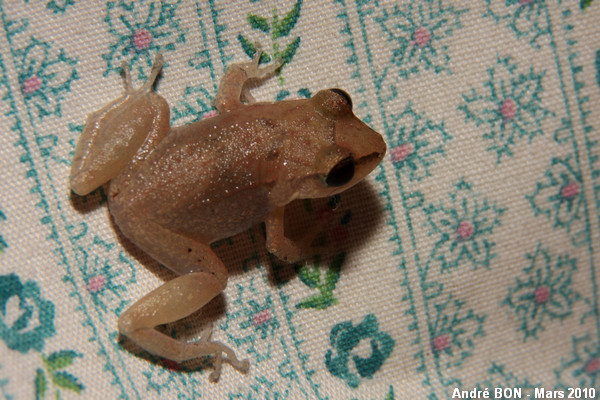


| Lesser Antillean Whistling Frog (Eleutherodactylus johnstonei (Barbour, 1914)) |



|
|
Scientific name: Eleutherodactylus johnstonei (Barbour, 1914) Common name: Lesser Antillean Whistling Frog French name: Hylode de Johnstone Order: Anura Family: Eleutherodactylidae Size: Body size: 17 to 25 mm for males and 17 to 35 mm for females. Habitat: Moderately damp areas: Woodland edges, bushes, gardens, banana plantations. It can adapt to habitats modified by human activities. Food: Small insects and arachnids caught on the ground (Ants, Springtails, Aphids, etc.) Reproduction: Males call females by whistling two adjacent notes. Females lay 8 to 20 eggs on the ground in a dark and damp location. Parents will watch the eggs till the small whistling frog hatch out (there is no larval stage as tadpole, in fact this development stage happens inside the egg before hatching out). Geographic area: Lesser Antilles. Introduced to Jamaica, Venezuela, Colombia, Guyana, Trinidad and Tobago and Panama. |
The Lesser Antillean Whistling Frog has a nocturnal activity and hides during the day. The upper side is pale brown to grey with usually two chevrons which point forward. There can be one pale dorsal line and/or two lateral pale brown lines. The Lesser Antillean Whistling Frog has a golden iris. The fingers end with adhesive disks. There are 4 species of whistling frog in Basse-Terre. The Grand Cafe Robber Frog or Pinchon's Piping Frog (Eleutherodactylus pinchoni), endemic to Basse-Terre in Guadeloupe, is the smallest. The upper side is dark brown and there are orange marks on the underside. It is found in highland forest as it needs damp and cold habitats. The Matouba Robber Frog (Eleutherodactylus barlagnei), endemic to Basse-Terre in Guadeloupe, is a dark colour. This species is found near torrents. The Martinique Robber Frog (Eleutherodactylus martinicensis), widespread in the Lesser Antilles, is considered as a native species while the Lesser Antillean Whistling Frog is an introduced species. You can tell the Martinique Robber Frog apart by its larger size (up to 47 mm). It also shows a large head, longer legs and larger toe disks. There is a competition between these two species. The extension of Lesser Antillean Whistling Frog populations causes a regression on Martinique Robber Frog populations. |
| [To know more about the Lesser Antillean Whistling Frog] [Next picture] [Top] |

|
I have observed these whistling frogs on the terrace of the bungalow. They song has animated our evenings. |
| [To know more about the Lesser Antillean Whistling Frog] [Next picture] [Previous picture] [Top] |

|
The Lesser Antillean Whistling Frogs have not been very shy during the photo session. I have been able to get very close without any problem. |
| [To know more about the Lesser Antillean Whistling Frog] [Previous picture] [Top] |

|
It is sometimes difficult to remember the exact size of the photographed animals. The fact that this Lesser Antillean Whistling Frog has climbed on my toilet bag now enables me to measure its exact body size, about 23 mm. This confirms the identification of the Lesser Antillean Whistling Frog as the other observed specimens were about the same size. I have found that this size was a little too small for Martinique Robber Frog. |